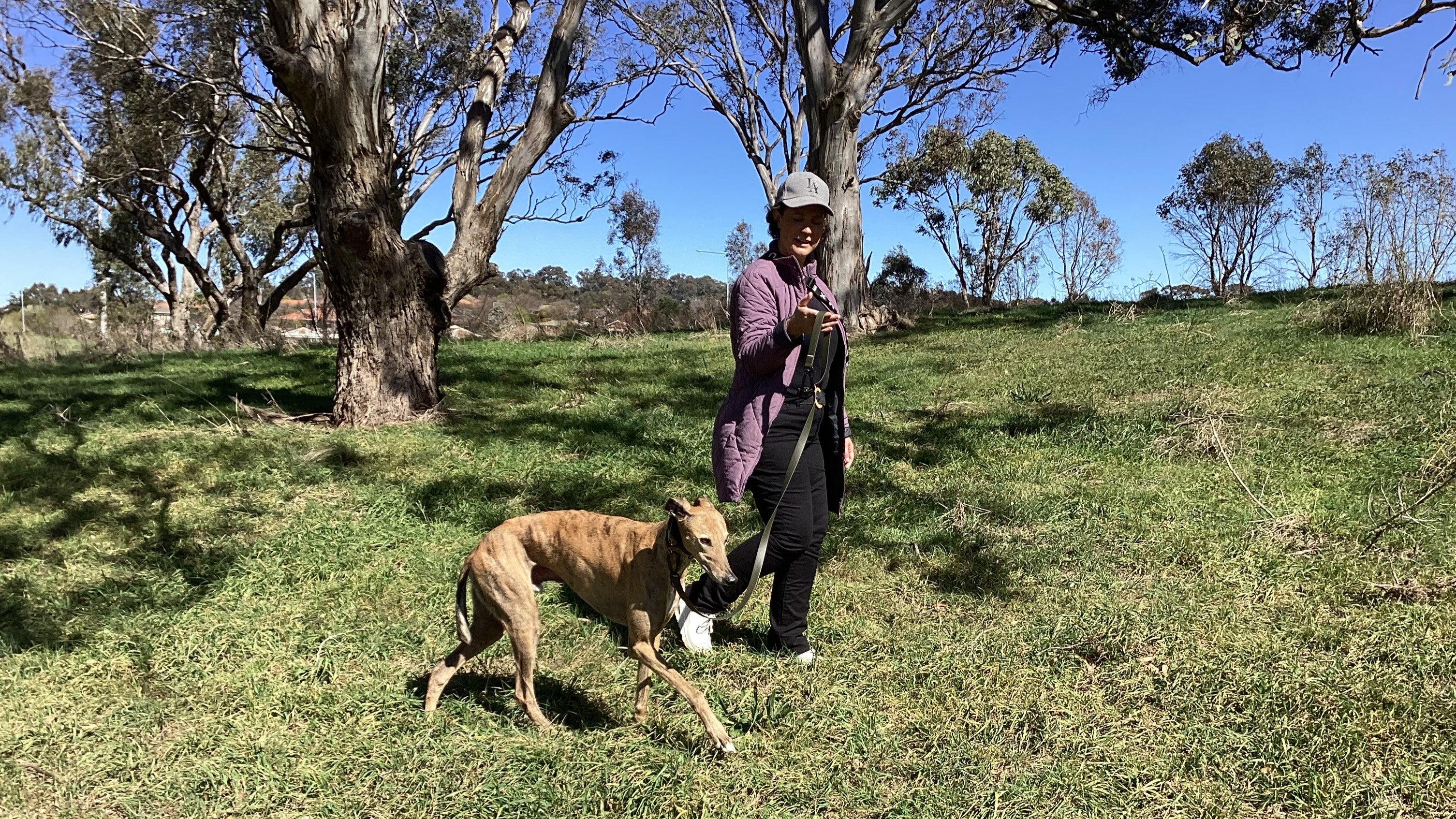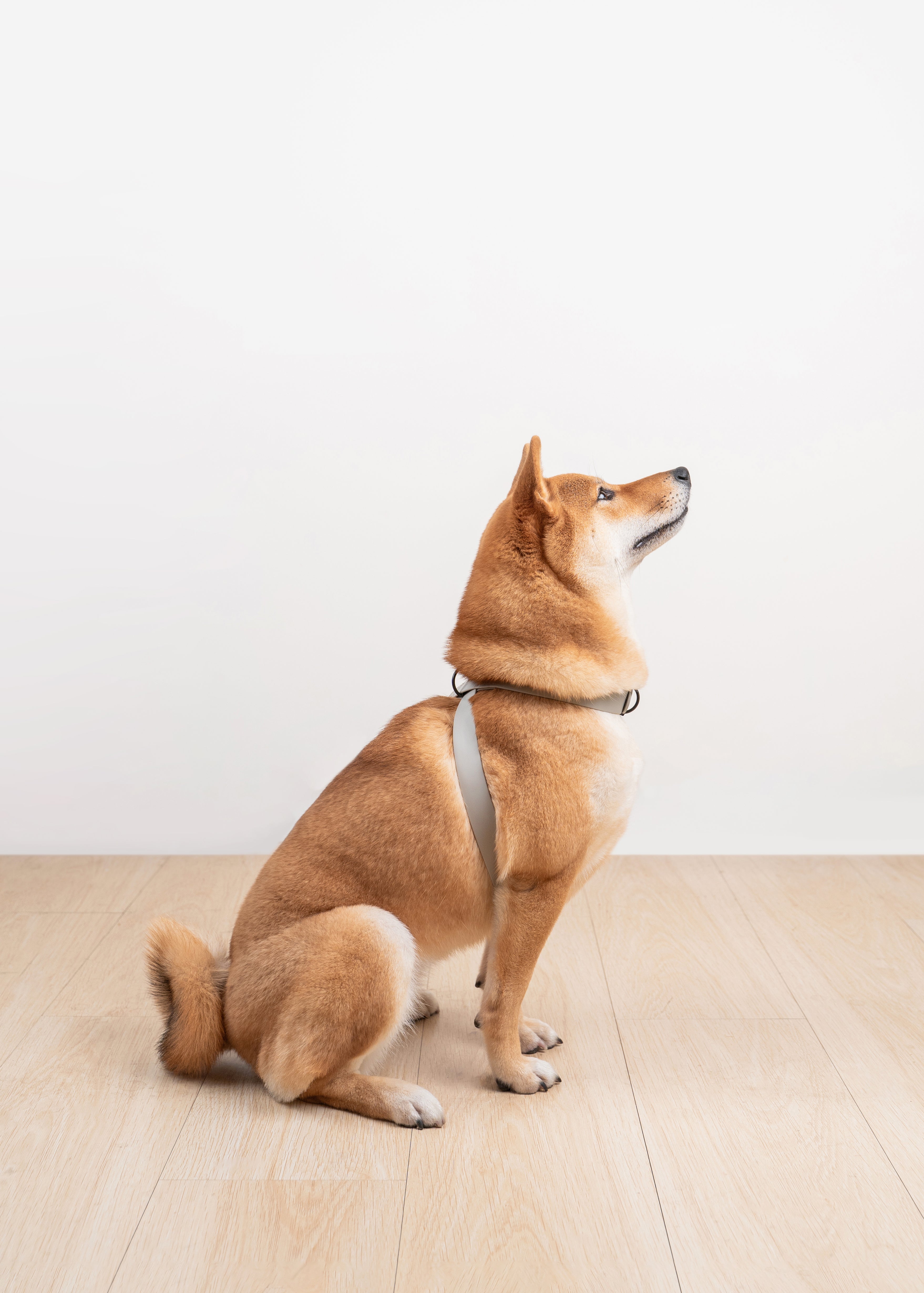Article: Communications through the right tools

Communications through the right tools

Starting a beautiful leash conversation: the story of Billy the ex-racing greyhound and Allie the dog trainer.
Guest post by Allie Macdonald from Sit Drop Stay
MEETING OUR RACER DOG
I’m a dog trainer in Australia and our company focuses on relationship based training methods to help owners and dogs improve their communication, trust, and respect. Over the years I got involved in helping greyhound rescue groups whose purpose is to transition racing dogs to life as pets.
Somehow during this process, I ended up with two large greyhounds of my own. They are a breed with a few quirks, and my wire haired vizsla.
My latest greyhound is a 9 year old brindle greyhound named Billy. He has a ¾ length tail amputation, bare patches where his fur no longer grows, and an unfortunate array of broken, mud brown teeth. Yet even at 9 years old, Billy is fighting fit and eager to learn. But Billy’s main challenge is he was never part of a family unit comprising humans.
CREATING A SECURE ATTACHMENT
Creating a secure attachment is terminology used to describe a healthy bond or connection. How this process works from a dog training point of view, is that Billy and I need to begin work together to build a healthy bond. We do this by participating in regular calm activities together, where clear communication and safety is our primary goal. This process builds trust. And we need Billy’s trust if we are to add to his skillset in the future. Bonding is an exercise that can be done by any owner and their dog with great benefits to the relationship at any stage of the journey. It is also very simple to do.
My regime with Billy involves practise direction change together on a standard leash and martingale collar as we move through the environment in a safe and effective way. Once Billy starts to recognise that my gentle pulses on the lead have meaning, his eyes light up and he starts to listen and synchronise with my movements.

DISCOVERING THE ART OF LEASH CONVERSATIONS
While we may not think so, the act of safely navigating through the environment while attached via a leash to a human, is a significant accomplishment for a dog. Especially one lacking life experience, like Billy. And believe it or not, dogs are constantly assessing our competence or lack thereof! The leash and collar system form an important part of our ability to communicate with our dog when used well.
And we can get the leash conversation wrong. Less than ideal applications of the leash, for example, are instances where constant tension is applied. Doing this can inadvertently communicate conflict/insecurity and reduce our dog’s confidence in us. Similarly, if we stop and stare at our dogs or the environment in an anxious manner, our dog senses we are not feeling safe and may act accordingly. From our dog’s point of view, the state of constant leash tension or random/jerky pressure, can contribute to increased frustration, anxiety and/or over stimulation.
In contrast, showing our dogs we are confident to use the leash as a guide and to communicate gently, reinforces the idea that we know what we are doing. It signals that we are using the leash as part of a conversation about what to do and where to go. The situation is no different for humans: when we receive valuable information we can reliably act on, we begin to trust the source.
TO MASTER LEASH COMMUNICATIONS, WE NEED TO:
- Cultivate a confident yet relaxed leadership mindset;
- Use gentle training gear that minimises pressure on our dogs; and
- Practise accurate timing of our words and our actions, to help our dogs make sense of information we convey.
HOW TO IMPROVE ON LEASH COMMUNICATIONS
It is important to spend some time daily doing bonding at home or in a quiet spot. I will share a 10-15min daily Leader-Follower exercise that I found useful for Billy and myself:
- Always use two hands in an “overhand hold”, and start in an environment with few distractions.
- Make sure the leash is mostly loose throughout the exercise.
- Train in a larger area to practise direction changes and/or turns in random directions, gently pulsing the lead at a 90-degree angle (where possible) to the collar as you turn and cue your dog’s name.
- As soon as your dog responds and begins to move in your direction, stop pulsing the lead, and calmly reward/praise as you move together.
- Allow short sniffing breaks but maintain momentum through forward motion.
- Try to avoid allowing your dog to come to an abrupt stop/surprise at the end of the leash and avoid keeping constant pressure on the leash system as much as possible.
- Allow some free time at the completion of the exercise for affection, calm cuddles, and sniffing.
The goal of these exercises is to enjoy a calm activity together. As you continue inviting your dog to move in your direction with you, notice how you start to synchronise and work together. Use fluid arcing movements, like long ski-turns and avoid abrupt turns. The purpose of the gentle leash pulse indicates to your dog something is about to happen and they must pay attention to what will happen next. Remember to stay calm and confident, move intentionally, but not at speed.
I encourage spending some time relaxing in your environment with your dog on a loose leash, without constant engagement or over stimulation. Calm co-existence is balancing for both human and dog and forms the foundation of a great relationship.

SELECTING THE RIGHT TOOLS
When I discovered the AVA Martingale Collar and MELLEM X Leash, I was impressed. I am a big fan of the martingale collar (with its limited slip design to stop dogs escaping) and a sturdy standard leash for teaching leash skills. Lambwolf has developed an impressive range of gear, especially the leashes and martingale collar range.
This gear is beautiful yet functional and has become a much loved training tool in my toolkit. The secure carabiner attachment adds an extra layer of safety, and means I can trust the attachment will not fail in the instance where increased loading may occur. The collar and leash are waterproof and can be easily washed. The gear does not hold water or smell, and most importantly works very well in the training context.
Not often do I come across form and function when it comes to dog training gear. The Lambwolf range has succeeded in creating a versatile range which trainers like me can use. The best part, is that every item arrives with its own washable cotton bag, which is so handy for keeping gear organised!

EVERYTHING TAKES TIME
Remember, building a bond with a dog takes time. Leash conversations are skills that don’t happen overnight. This is why the right tools, used well and safely, can make all the difference. I believe that dog owners act as a bridge between their dog and his/her environment, so it is very important to get the communication right. For Billy, the benefits of a calm and considered approach, starting with a simple system he easily understands, has made all the difference to his confidence levels.
Who said old dogs can’t learn new tricks? … and look stylish at the same time!
Love,
Allie + Billy @sitdropstay
*Disclaimer: I only speak from a personal experience and research. The best methods that worked for us may not be the best methods for you and your dogs. Please consult with a professional trainer for your individualized training plans.


